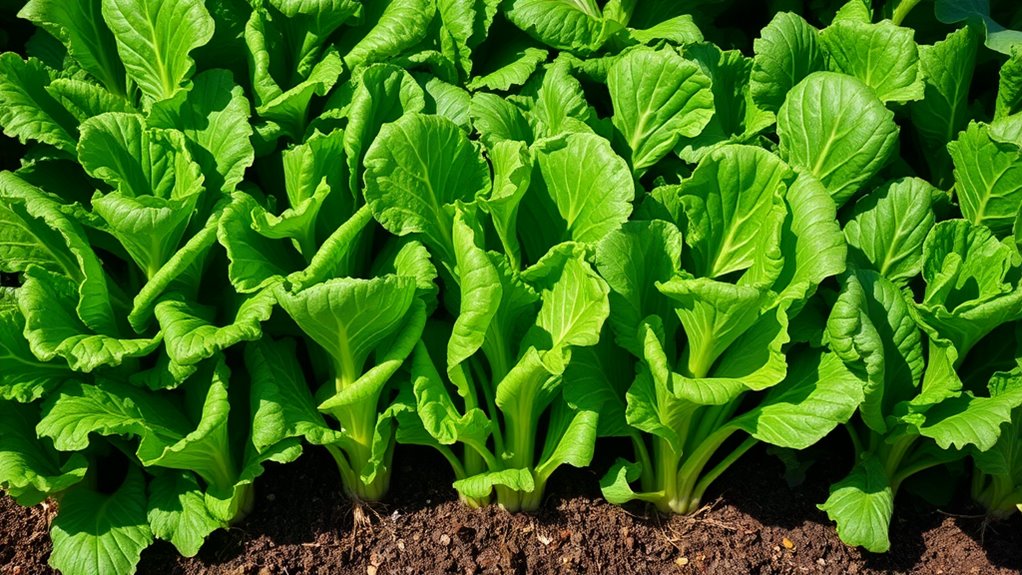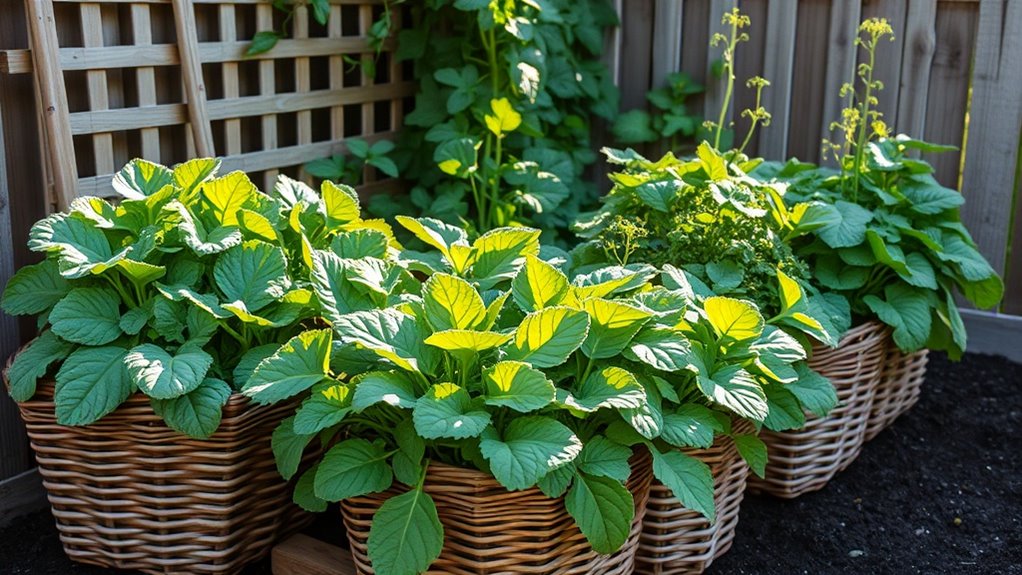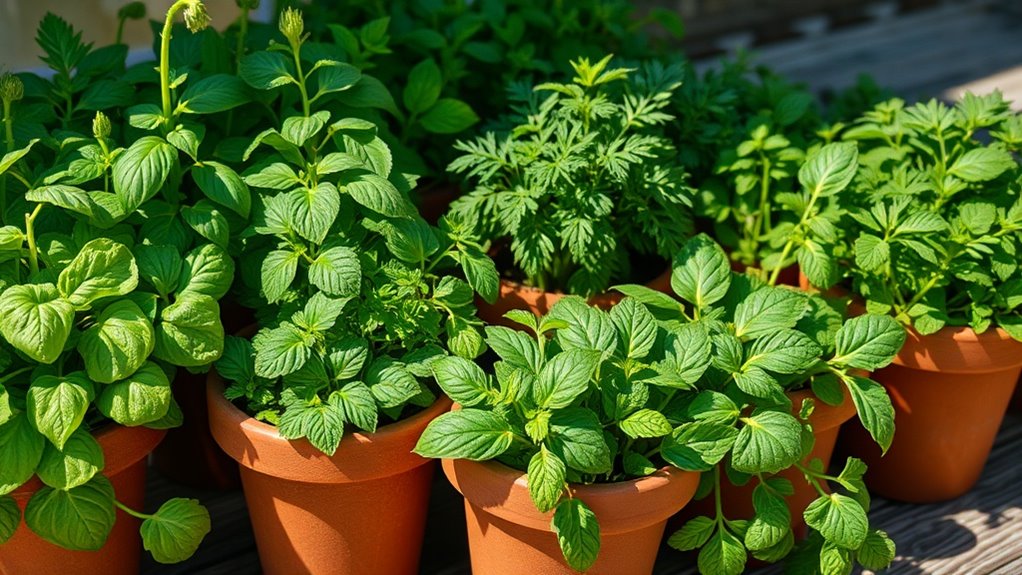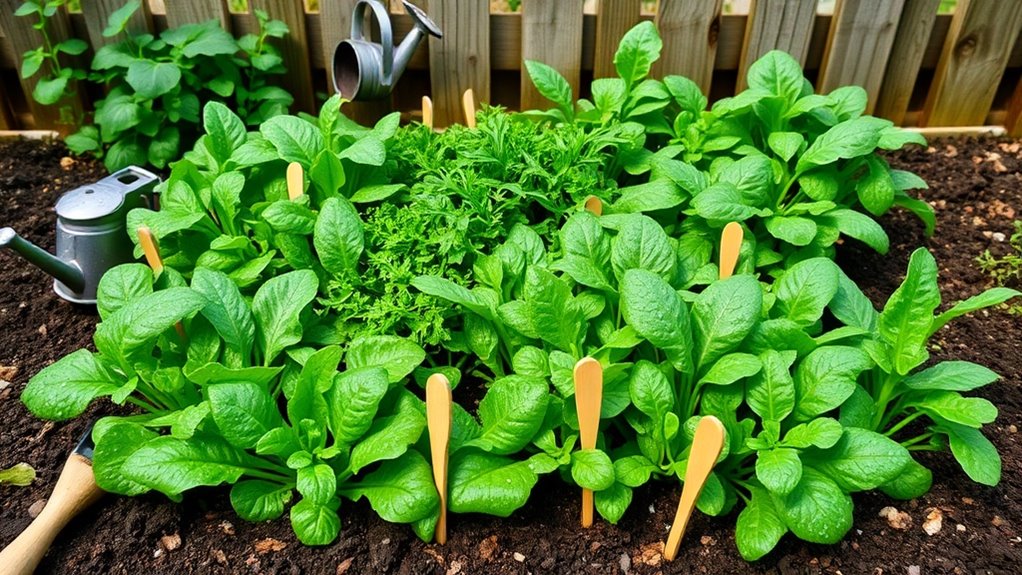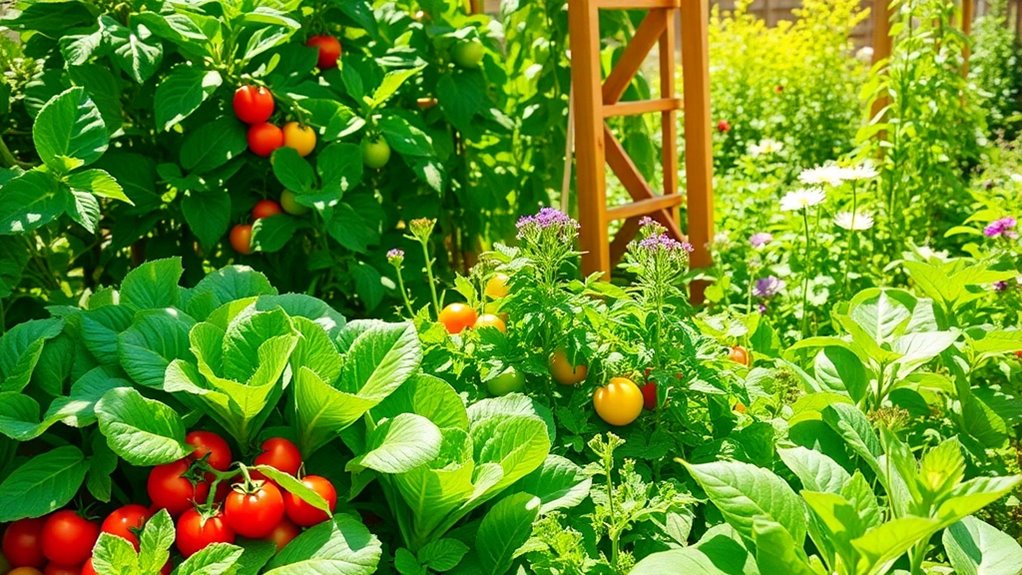Leafy Greens That Keep Growing After You Harvest Them
Did you know that many leafy greens can regrow after you harvest them? This unique ability allows you to enjoy a continuous supply of fresh greens right from your garden. By using the cut-and-come-again method, you can selectively harvest outer leaves while keeping the inner core intact. This technique not only maximizes yield but also enhances the nutritional value of your meals. Discover which greens thrive best with this method and how to cultivate them effectively.
Key Takeaways
- Kale regrows when outer leaves are harvested, leaving about two inches of stem intact for continuous yields throughout the season.
- Swiss chard promotes regrowth by cutting outer leaves while allowing inner ones to develop, ensuring fresh supplies.
- Spinach encourages regrowth by harvesting outer leaves and leaving inner ones, redirecting energy towards new growth.
- Lettuce varieties, including Butterhead and Looseleaf, regrow by snipping outer leaves and maintaining the inner core for ongoing growth.
- Arugula supports continuous harvests by cutting outer leaves, allowing inner leaves to thrive and produce more greens.
Kale: A Nutrient Powerhouse That Rebounds
Kale, often hailed as a nutrient powerhouse, offers gardeners a unique advantage: it can regrow after harvest, making it a sustainable choice for your garden.
To successfully regrow leafy greens like kale, harvest the outer leaves first, allowing the inner leaves to continue developing.
Ensure you leave about two inches of the stem intact to promote new growth.
Regular watering and ample sunlight are crucial for robust regrowth.
Be mindful of pests and diseases that can affect your kale.
With proper care, you can enjoy multiple harvests, boosting your garden’s yield while maximizing nutrition for your meals. Additionally, kale is part of the cut and come again greens category, which encourages ongoing harvesting throughout the growing season.
Swiss Chard: Versatile and Resilient
Swiss chard stands out as a versatile and resilient leafy green, thriving in various climates and conditions. You can grow it in both cool and warm weather, making it an excellent choice for year-round gardening. Its vibrant stems and broad leaves not only add color to your garden but also provide numerous nutritional benefits, including high levels of vitamins A, C, and K. When harvesting, cut the outer leaves, allowing the inner ones to continue growing. Regularly watering and applying balanced fertilizer will encourage robust growth, ensuring you can enjoy fresh Swiss chard throughout the season without replanting. Additionally, its regrowth potential allows for multiple harvests from a single planting, making it a sustainable choice for home gardeners.
Spinach: Quick to Regrow After Harvest
Spinach is a remarkable leafy green known for its rapid regrowth after harvesting, making it a favorite among gardeners seeking a quick and continuous supply of fresh greens.
To maximize regrowth, harvest the outer leaves, leaving the inner ones intact.
This technique encourages the plant to redirect energy toward new leaf production.
Spinach thrives in cooler temperatures, so aim for spring or fall planting.
Water consistently to maintain soil moisture, and consider using organic fertilizers to enhance growth.
With proper care, you can enjoy multiple harvests from the same plant, ensuring a steady supply of nutritious, vibrant spinach throughout the season. Additionally, spinach is one of the quick salad greens that can be harvested in just two weeks, making it an ideal choice for home gardening.
Lettuce: Cut-and-Come-Again Varieties
When it comes to cut-and-come-again lettuce varieties, you’ll find several options that not only thrive in various conditions but also provide continuous harvests. Understanding the best varieties to grow, along with proper harvesting techniques, can significantly enhance your gardening success. Additionally, these nutrient-rich greens offer numerous health benefits, making them an excellent choice for your home garden. Incorporating reusable gardening techniques can further ensure the sustainability of your mini salad garden.
Best Varieties to Grow
If you’re looking to maximize your harvest while minimizing waste, cut-and-come-again lettuce varieties are a fantastic choice.
Varieties like Butterhead and Looseleaf are perfect for this method, as they regrow quickly after harvesting.
Butterhead offers tender leaves with a rich flavor, while Looseleaf varieties, such as Red Romaine, provide vibrant colors and crisp textures. Notably, Oakleaf lettuce is another excellent option, known for its unique leaf shape and resilience.
These varieties thrive in well-drained soil and benefit from regular watering, ensuring continuous growth.
Harvesting Techniques Explained
How can you ensure a bountiful harvest from your cut-and-come-again lettuce varieties?
Begin by using sharp, clean scissors or shears to snip outer leaves, leaving the inner core intact.
Aim for harvesting when leaves are at least 4 inches long, as this promotes vigorous regrowth.
Avoid cutting too close to the base; leaving about an inch helps protect the plant.
Harvest in the morning when moisture levels are higher, enhancing leaf freshness.
Regularly inspect for pests and disease, ensuring optimal conditions for growth.
With proper techniques, your lettuce can yield multiple harvests throughout the growing season.
Nutritional Benefits Overview
Cut-and-come-again lettuce varieties aren’t just easy to grow; they’re also packed with essential nutrients that can enhance your diet.
These greens provide a rich source of vitamins A, C, and K, which support eye health, immune function, and bone density.
They’re low in calories yet high in fiber, aiding digestion and promoting satiety.
Additionally, the antioxidants found in lettuce help combat oxidative stress, contributing to overall wellness.
Regular consumption can improve hydration due to their high water content.
Arugula: Fast-Growing With Continuous Harvests
While arugula may not take long to grow, its capacity for continuous harvests makes it a favorite among gardeners and chefs alike.
You can sow arugula seeds directly into well-drained soil, ensuring they’re spaced about 6 inches apart.
Once the leaves reach 3-4 inches, you can start harvesting by cutting outer leaves, allowing the inner ones to continue growing.
This cut-and-come-again method promotes regrowth, giving you fresh greens over several weeks.
Keep in mind that arugula thrives in cooler temperatures—ideal for spring and fall planting—so be mindful of excessive heat, which can cause bitterness and rapid bolting. Additionally, incorporating well-drained soil is vital for optimal growth and health of your salad garden.
Mustard Greens: Spicy Flavor With Regrowth Potential
Mustard greens offer a unique spicy flavor along with impressive nutritional benefits, making them a valuable addition to your garden. To maximize their regrowth potential after harvesting, you’ll want to employ specific techniques and create ideal growing conditions. Understanding these factors will enhance both your yield and the overall quality of your mustard greens. Additionally, ensuring that your mustard greens receive adequate soil preparation will significantly contribute to their ability to thrive after each harvest.
Nutritional Benefits of Mustard
Have you ever considered the nutritional powerhouse that’s mustard greens?
Packed with vitamins A, C, and K, these leafy greens support immune function, skin health, and bone strength.
Rich in antioxidants, mustard greens help combat oxidative stress, reducing chronic disease risk.
Their high fiber content promotes digestive health and aids weight management.
Additionally, they contain essential minerals like calcium, iron, and magnesium, which are crucial for bone health and energy production.
Incorporating mustard greens into your diet not only adds a spicy kick to your meals but also delivers a range of health benefits that enhance your overall well-being.
Harvesting Techniques for Regrowth
How can you effectively harvest mustard greens to encourage regrowth?
Start by using sharp, clean scissors or garden shears. Cut the outer leaves near the base of the plant, leaving the inner leaves and crown intact.
This technique minimizes stress and promotes new growth.
Aim to remove no more than one-third of the plant at a time to maintain its vitality. Harvest in the morning when leaves are crisp for the best flavor.
After cutting, water the plant to support regrowth. Regularly harvesting encourages a continuous supply of fresh mustard greens while maintaining plant health.
Ideal Growing Conditions
Creating the perfect environment for growing mustard greens is essential for maximizing their spicy flavor and regrowth potential.
Aim for well-drained, fertile soil with a pH between 6.0 and 7.0.
Mustard greens thrive in full sun, requiring at least 6 hours of direct sunlight daily.
Maintain consistent moisture, but avoid waterlogging; irrigate when the top inch of soil feels dry.
Fertilize with a balanced, organic fertilizer to support robust growth.
Ideal temperatures range from 50°F to 75°F.
Plant in early spring or fall for optimal flavor and allow for staggered harvests, ensuring continuous fresh growth throughout the season.

